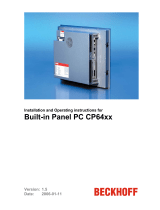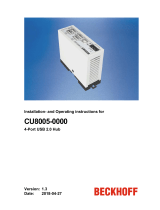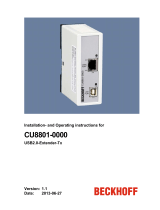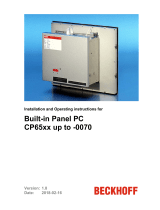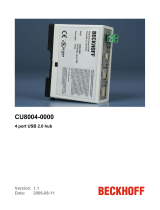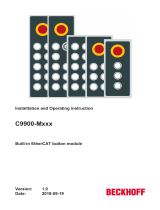Page is loading ...

Installation and Operating Manual for
C9900-G0xx
Push-Button Extension for Multi-Touch Control Panel
- CP2xxx
- CP39xx
Version: 1.3
Date: 2018-01-11


Table of contents
C9900-G0xx 1
Table of contents
1 Foreword 3
1.1 Notes on the documentation 3
1.1.1 Disclaimer 3
1.1.2 Brands 3
1.1.3 Patents 3
1.1.4 Copyright 3
1.1.5 Delivery state 3
1.1.6 Delivery conditions 3
1.2 Description of safety symbols 4
1.3 Basic safety measures 5
1.4 Operator's obligation to exercise diligence 6
1.4.1 National regulations 6
1.4.2 Procedure in the event of a fault 6
1.4.3 Operator requirements 6
2 Product description 7
2.1 Product overview 7
2.2 Intended use 8
2.3 Accessing the connections 8
2.3.1 CP2xxx 8
2.3.2 CP39xx without mounting arm adapter 9
2.3.3 CP39xx with mounting arm adapter 10
2.4 Connections 11
2.4.1 Description of the PCBs 11
2.4.2 Configuration 14
2.4.3 Toggle switch 15
2.5 Wiring of the connection strips 15
2.6 Inserting self-printed labels 16
3 Special instructions for the TwinCAT System Manager 17
3.1 From TwinCAT 2.11 build 2245 18
4 Installation 19
4.1 Transport and unpacking 19
4.1.1 Transport 19
4.1.2 Unpacking 19
4.2 Connecting the push-button extension 20
4.2.1 Connecting cables 20
5 Operation 21

Table of contents
2 C9900-G0xx
5.1 Maintenance 21
5.1.1 Cleaning 21
5.1.2 Maintenance 21
5.2 Emergency procedures 21
5.3 Decommissioning 21
5.3.1 Disposal 21
6 Technical data 22
7 Appendix 23
7.1 Service and support 23
7.1.1 Beckhoff's branch offices and representatives 23
7.2 Headquarters 23
7.2.1 Beckhoff Service 23
7.2.2 Beckhoff Support 23
7.3 PCBs used in keyboard extensions 24
7.4 Circuit diagrams 25
7.4.1 Circuit diagram for emergency off PCB 25
7.4.2 Circuit diagram for three-button PCB 26
7.4.3 Circuit diagram for four-button PCB 27
7.5 FCC certifications for the United States of America 28
7.6 FCC certifications for Canada 28

Foreword
C9900-G0xx 3
1 Foreword
1.1 Notes on the documentation
This description is only intended for the use of trained specialists in control and automation technology
familiar with the applicable national standards.
It is essential that the following notes and explanations are followed when installing and commissioning
these components. The responsible staff must ensure that the application or use of the products
described satisfy all the safety requirements, including all the relevant laws, regulations, guidelines and
standards.
1.1.1 Disclaimer
This documentation has been prepared with care. The products described are, however, constantly under
development. For this reason, the documentation may not always have been fully checked for
consistency with the performance data, standards or other characteristics described. If it should contain
technical or editorial errors, we reserve the right to make changes at any time and without notice. No
claims for the modification of products that have already been supplied may be made on the basis of the
data, diagrams and descriptions in this documentation.
1.1.2 Brands
Beckhoff
®
, TwinCAT
®
, EtherCAT
®
, Safety over EtherCAT
®
, TwinSAFE
®
and XFC
®
are registered
trademarks of and licensed by Beckhoff Automation GmbH.
The use by third parties of other brand names or trademarks contained in this documentation may lead to
an infringement of the rights of the respective trademark owner.
1.1.3 Patents
The EtherCAT technology is patent protected, in particular by the following applications and patents:
EP1590927, EP1789857, DE102004044764, DE102007017835 with the corresponding applications and
registrations in various other countries.
The TwinCAT technology is patent protected, in particular by the following applications and patents:
EP0851348, US6167425 with the corresponding applications and registrations in various other countries.
1.1.4 Copyright
©
Beckhoff Automation GmbH.
The copying, distribution and utilization of this document as well as the communication of its contents to
others without express authorization is prohibited. Offenders shall be held liable for damages. All rights
conferred by patent grant or registration of a utility model or registered design are reserved.
1.1.5 Delivery state
All the components are supplied in particular hardware and software configurations appropriate for the
application. Modifications to hardware or software configurations other than those described in the
documentation are not permitted, and nullify the liability of Beckhoff Automation GmbH.
1.1.6 Delivery conditions
In addition, the general delivery conditions of the company Beckhoff Automation GmbH apply.

Foreword
4 C9900-G0xx
1.2 Description of safety symbols
The following safety symbols are used in these operating instructions. They are intended to alert the
reader to the associated safety instructions.
DANGER
Serious risk of injury!
Failure to follow the safety instructions associated with this symbol directly endangers
the life and health of persons.
WARNING
Caution - Risk of injury!
Failure to follow the safety instructions associated with this symbol endangers the life
and health of persons.
CAUTION
Personal injuries!
Failure to follow the safety instructions associated with this symbol can lead to injuries
to persons.
Attention
Damage to the environment or devices
Failure to follow the instructions associated with this symbol can lead to damage to the
environment or equipment.
Note
Tip or pointer
This symbol indicates information that contributes to better understanding.

Foreword
C9900-G0xx 5
1.3 Basic safety measures
Before the Industrial PC is switched off, software that is running must be properly closed. Otherwise data
can get lost.
Attention
Switch off system components and disconnect the Control Panel from the
system
Before opening the housing, and whenever the control panel is not being used for
control purposes (such as during functional checks after a repair), all parts of the
equipment must first be switched off, after which the control panel is to be
disconnected from the equipment.
Disconnect the Control Panel by releasing the connectors at the back. System components that have
been switched off must be secured against being switched on again.
Attention
Do not exchange any parts when under power
When components are being fitted or removed, the supply voltage must be switched
off.
Assembly work can cause damage:
if metal objects such as screws or tools fall onto operating circuit boards.
if cables are connected or disconnected during operation.

Foreword
6 C9900-G0xx
1.4 Operator's obligation to exercise diligence
The operator must ensure that
the products are only used as intended (see Product description chapter);
the products are only operated in sound condition and functioning properly.
the products are operated only by suitably qualified and authorized personnel.
the personnel is instructed regularly about relevant occupational safety and environmental
protection aspects, and is familiar with the operating instructions and in particular the safety
instructions contained herein.
the instruction manual is in good condition and complete, and always available for reference at
the location where the products are used.
1.4.1 National regulations
Depending on the type of machine and plant in which the product is used, national regulations governing
the controllers of such machines will apply, and must be observed by the operator. These regulations
cover, amongst other things, the intervals between inspections of the controller. The operator must initiate
such inspections in good time.
1.4.2 Procedure in the event of a fault
In the event of product malfunctions please contact Headquarters
Beckhoff Automation GmbH
Eiserstraße 5
33415 Verl
Germany
Phone: + 49 (0) 5246/963-0
Fax: + 49 (0) 5246/963-198
E-mail: [email protected]
Beckhoff Service.
1.4.3 Operator requirements
All users of the product must have read the operating instructions and be aware of all the functions they
can access.

Product description
C9900-G0xx 7
2 Product description
2.1 Product overview
Fig. 1: CP3918 with push-button extension C9900-G025 (one emergency stop button, ten illuminated
push buttons)
The optional C990-G0xx push-button extensions for the Control Panels CP2xxx and CP39xx from
Beckhoff Automation provide additional input options. Push-button extensions that match the design of
the Control Panels enable application-specific use of electromechanical buttons. Selection and key
switches can also be integrated. The push-button extension is located below the touchscreen. The
number of buttons that can be added depends on the display size.
The actuation of the emergency stop and other buttons is transferred to the controller via USB and can be
read with TwinCAT. Optionally, customers may use the signals for additional purposes. The emergency
stop has two N/C contacts and one N/O contact. The signal of the N/O contact is transferred to the
controller. The two N/C contacts can be used by the customer. One button actuates two N/O contacts,
one of which is available as a potential-free contact for use by the customer. The indicator lamps are
controlled via USB.
By default the first button is supplied with a green cap, the second with a red cap, and the other buttons
with white caps (see Fig. 1). Other button cap color options are available for retrofitting:
C9900-Z255: 5 button caps (blue)
C9900-Z256: 5 button caps (yellow)
C9900-Z257: 5 button caps (green)
C9900-Z258: 5 button caps (red)
C9900-Z259: 5 button caps (white)
A label sheet with 54 pre-punched button labels is available under order code C9900-Z260. Application of
the labels is explained in section 2.6.
Custom adaptations are possible on request.

Product description
8 C9900-G0xx
2.2 Intended use
The multi-touch Control Panels CP2xxx and CP39xx with push-button extension C9900-G0xx are
designed for industrial machine and systems engineering applications. The push-button extension is
located below the touchscreen.
DANGER
Risk of explosion!
The Control Panels must not be used in potentially explosive atmospheres.
2.3 Accessing the connections
The push-button extension connections for use by the customer are located at the rear of the housing. To
access the connections remove the cover panel at the rear. The exact procedure depends on the housing
type and mounting arm.
2.3.1 CP2xxx
Release the M3 screws around the perimeter of the button cover (see Fig. 2) and remove the cover. The
number of screws may vary, depending on the display size. The potential-free contacts are now
accessible. The cabling can be fed out of the housing via the M20 cable gland shown in Fig. 2. Attach the
button cover and secure it with the screws.
Fig. 2: CP2924-0000-G007 with or without button cover

Product description
C9900-G0xx 9
2.3.2 CP39xx without mounting arm adapter
Release the M3 screws around the perimeter of the button cover (see Fig. 3) and remove the cover. The
number of screws may vary, depending on the display size. The potential-free contacts are now
accessible. The cabling can be fed out of the housing via the M20 cable gland. Attach the button cover
and secure it with the screws.
Fig. 3: CP3919-0000-G026 with or without button cover

Product description
10 C9900-G0xx
2.3.3 CP39xx with mounting arm adapter
For Control Panels with mounting arm adapter (C9900-M752 and C9900-M753), release the M3 screws
(labelled 1 in Fig. 4) around the perimeter of the button cover and release it. Release the screws labelled
2 in Fig. 4 and remove the cover. Then remove the cover panel (3). The cover panel can easily be
levered off with a suitable tool to enable access to the connections. The potential-free contacts are now
accessible. The cabling can be guided into the mounting arm adapter through the cable channel and M20
gland shown in Fig. 5. Re-assemble the button cover and the cover panel in reverse order.
Fig. 4: CP3919-0000-G023-M752
Fig. 5: CP3919-0000-G023-M752 without button cover and cover panel
①
②
②
③

Product description
C9900-G0xx 11
2.4 Connections
2.4.1 Description of the PCBs
This section describes and explains the PCBs for the buttons and their connections. Each PCB has
connection strips to enable customers to use the buttons and the emergency stop. The pin assignment of
the connection strips is shown on each PCB. The circuit diagrams for each of the three PCBs used can
be found in the annex under section 7.4. The connector designations (CONxxx) used in this description
refer to these circuit diagrams.
Emergency stop PCB
Fig. 6: Emergency stop PCB
The emergency stop PCB has a USB (1, CON500) and a K-bus interface (2, CON400). Both interfaces
are used for signal transfer and are assigned ex factory. A further connection strip (3, CON402) is
available for customer use via the two additional N/C contacts of the emergency stop.
Not more than 24 V are allowed to be connected to the emergency stop PCB!
The connection strip assignment is shown in Table 1.
Connection
strip
Terminal point Description
3
1 Input N/C contact 1
2 Output N/C contact 1
3 Input N/C contact 2
4 Output N/C contact 2
5 Not used
6 Not used
Table 1: Pin assignment for emergency stop PCB

Product description
12 C9900-G0xx
Three-button PCB
Fig. 7: Three-button PCB
The three-button PCB has two K-bus interfaces (1, CON400 & CON401), which are assigned ex factory.
The outer connection strips (2, CON600 & CON601) are used for power supply for the indicator lamps,
connection strip 4 is available for customer use. The bridges between the button PCBs are assigned ex
factory. The power supply has to be provided by the customer. One of the two N/O contacts of each
button is available for customer use via a connection strip (3, CON603). At a further connection strip (4,
CON602) three digital inputs are available for customer use, which are transferred via the K-bus. The 24
V supply has to be provided by the customer. The PCB also features a DIP switch (5, SW600), which is
explained in section 2.5.
Not more than 24 V are allowed to be connected to the three-button PCB!
The pin assignments for connection strips 2, 3 and 4 are listed in Table 2.
Connection
strip
Terminal
point
Description
2
1 24 V DC
2 0 V
3
1 Input N/O contact 1
2 Output N/O contact 1
3 Input N/O contact 2
4 Output N/O contact 2
5 Input N/O contact 3
6 Output N/O contact 3
4
1 24 V output
2 Digital input 1
3 24 V output
4 Digital input 2
5 24 V output
6 Digital input 3
Table 2: Pin assignment for three-button PCB

Product description
C9900-G0xx 13
Four-button PCB
Fig. 8: Four-button PCB
The four-button PCB also has two K-bus interfaces (1, CON400 & CON401), which are assigned ex
factory. The outer connection strips (2, CON600 & CON601) are used for power supply for the indicator
lamps, connection strip 4 is available for customer use. The bridges between the button PCBs are
assigned ex factory. The power supply has to be provided by the customer. One of the two N/O contacts
of each button is available for customer use via a connection strip (3, CON603). At a further connection
strip (4, CON604) four digital inputs are available for customer use, which are transferred via the K-bus.
The 24 V supply has to be provided by the customer. The PCB also features a DIP switch (5, SW600),
which is explained in section 2.5.
Not more than 24 V are allowed to be connected to the four-button PCB!
The pin assignments for connection strips 2, 3 and 4 are listed in Table 3.
Connection
strip
Terminal
point
Description
2
1 24 V DC
2 0 V
3
1 Input N/O contact 1
2 Output N/O contact 1
3 Input N/O contact 2
4 Output N/O contact 2
5 Input N/O contact 3
6 Output N/O contact 3
7 Input N/O contact 4
8 Output N/O contact 4
4
1 24 V output
2 Digital input 1
3 24 V output
4 Digital input 2
5 24 V output
6 Digital input 3
7 24 V output
8 Digital input 4
Table 3: Pin assignment for four-button PCB

Product description
14 C9900-G0xx
2.4.2 Configuration
Each configuration features an emergency stop PCB, which contains the USB K-bus coupler. The
remainder of the configuration of the three- and four-button PCBs depends on the display size. Some
examples are shown in Table 4 examples below. A detailed list of combinations can be found in the
annex in section 7.3.
Designation
Number of
Keys
Alignment
Emergency stop
PCB
Three-button
PCB
Four-button
PCB
C9900-G022 4 Horizontal ● - ●
C9900-G023 7 Horizontal ● ● ●
C9900-G024 8 Horizontal ● - ●●
…
C9900-G027 13 Horizontal ● ●●● ●
Table 4: Button PCB combinations
Fig. 9 shows a possible configuration and the factory state, using the CP2924-0000-G007 as an example.
Fig. 9: Rear view of CP2924-0000-G007
USB input
The USB input is located on the emergency stop PCB. The push-button extension is controlled via the
USB port of the CP39xx/CP2xxx. The USB input is pre-wired in the factory.
K-bus
The conversion from USB to K-bus takes place on the emergency stop PCB. The button PCBs are
connected via the K-bus interface of the emergency stop PCB. Each button PCB has a K-bus input and a
K-bus output. The last button PCB is terminated with a jumper at the K-bus output. The K-bus wiring of
the PCBs is done in the factory.
Power supply
The button PCBs are supplied via the voltage input of the first button PCB, from where the power supply
is looped to the next button PCB with a connecting cable, and so on. The connecting cables are provided
ex factory. The wiring of the voltage input is done by the customer.
Connector strips
On the PCBs connection strips are available so that the signals can be used for additional purposes. The
wiring is done by the customer.

Product description
C9900-G0xx 15
2.4.3 Toggle switch
An application example for the connection strips is the use of a toggle switch. If a toggle switch is installed
instead of a button, which is to be queried electronically in two positions, the potential-free contact of the
button (see item 3 in Fig. 7 & Fig. 8) can be used for this purpose. The N/O contact can be read-in with
the aid of the additional digital input (see item 4 in Fig. 7 & Fig. 8).
2.5 Wiring of the connection strips
Releasing the spring contact strip
The connection strip can be wired in unconnected or connected state. To release the spring contact strip
from the pin contact strip, use a suitable tool, for example a screwdriver, to guide the locking device in the
direction of the connection strip. The spring contact strip can be removed from the handle plate while the
locking device is held in this position.
Fig. 10: Releasing the spring contact strip
Wiring
The cables are connected as follows:
1. Open a spring-loaded terminal by slightly pushing with a screwdriver or a rod into the square
opening above the connection strip.
2. The wire can now be inserted into the round terminal opening without any force.
3. The terminal closes automatically when the pressure is released, holding the wire safely and
permanently.
Not more than 24 V are allowed to be connected to the button or emergency stop PCB!
Connecting to 24 V
The power supply has to be provided by the customer. The customer has to connect 24 V to the first push
button PCB (see Fig. 11). The connected 24 V can be switched with the push buttons and are used to
supply the mounted LEDs.
Fig. 11: Connection of 24 V power supply

Product description
16 C9900-G0xx
DIP switch
The dip switch can be used to loop the 24 V supply of the PCB (see item 2 in Fig. 7 & Fig. 8) directly via
the second N/O contact of a button. In this way the cabling effort at the pin contact strip (see item 3 in Fig.
7 & Fig. 8) can be reduced.
Example:
Button 1 needs to switch 24 V. Turn the DIP switch to position 1 (see Fig. 12). If button 1 is now actuated,
24 V is applied to contact 2 on the connector strip 3.
Fig. 12: Configuration of the DIP-switch
2.6 Inserting self-printed labels
The blank label sheets for the push buttons of the push-button extension offered under order code
C9900-Z260 can be printed with a conventional office printer and then inserted in the push-button
extension.
Fig. 13: Releasing the button cap and inserting the label
First remove the button caps of the buttons that are to be labelled. Use a suitable tool, for example a
screwdriver, to lever off the button caps and remove them. Then remove the labels from the sheet and
place them in button caps. The labels have tabs to aid alignment. Then place the button cap with the label
on the button and push it in.
Fig. 14: Replacing the button caps

Special instructions for the TwinCAT System Manager
C9900-G0xx 17
3 Special instructions for the TwinCAT System
Manager
The push-button extension can be integrated via the search
function in the System Manager. The PCBs in use are shown
as terminals in the System Manager (see Fig. 10).
KL1002 stands for the emergency off PCB. Channel 1 is the
N/O contact actuated by the emergency stop. Channel 2 is
not used.
The terminals following the KL1002 represent the button
PCBs used in the configuration. The number of displayed
inputs and outputs is independent of the number of buttons
on a PCB.
For a three-button PCB the inputs “Button 1” to “Button 3”
correspond to the N/O contacts that are actuated by the
respective buttons. The inputs “Button 4” to “Button 6”
correspond to the digital inputs that are allocated for
customer use. “Button 7” and “Button 8” are not used. The
outputs “LED 1” to “LED 3” are connected to the indicator
lamps. “LED 4” to “LED 8” are not used.
For a four-button PCB the inputs “Button 1” to “Button 4”
correspond to the N/O contacts that are actuated by the
respective buttons. “Button 5” to “Button 8” correspond to the
digital inputs that are allocated for use by the customer. “LED
1” to “LED 4” are connected to the indicator lamps. “LED 5” to
“LED 8” are not used.
Since it is not directly apparent from the diagram which PCB
is at which location, section 7.3 of the annex contains an
overview of PCB combinations for different devices. Please
note that in cases where three- and four-button PCBs are
combined, the three-button PCBs are always listed first.
Fig. 15: Push-button extension in the System
Manager

Special instructions for the TwinCAT System Manager
18 C9900-G0xx
3.1 From TwinCAT 2.11 build 2245
Build 2245 was added as a new option in the TwinCAT System Manager. KL1002 and CPx9xx-8
terminals found via the search function can be changed via the function “Change to compatible type”. The
display of the inputs and outputs then matches the actual inputs and outputs.
Fig. 16: Change to compatible types
Right-click on the terminal to be changed and select the option “Change to Compatible Type…”. The next
field then shows all compatible types. Table 5 shows the type to be selected. Once the change has been
implemented, only the inputs and outputs that can actually be used are shown.
Found terminal Compatible type Hardware
KL1002 CPx9xx-E-Stop Emergency stop PCB
CPx9xx-8 CPx9xx-3-2 Three-button PCB
CPx9xx-8 CPx9xx-4-2 Four-button PCB
Table 5: Found terminals and compatible types
Please refer to the table in annex 7.3 regarding the hardware present in your device.
/
